"Art is the Purest Form of Communication"
A conversation with Boston-based photographer Mike Ritter
The Saturday Brunch: a figurative flat white or fizzy to start your weekend
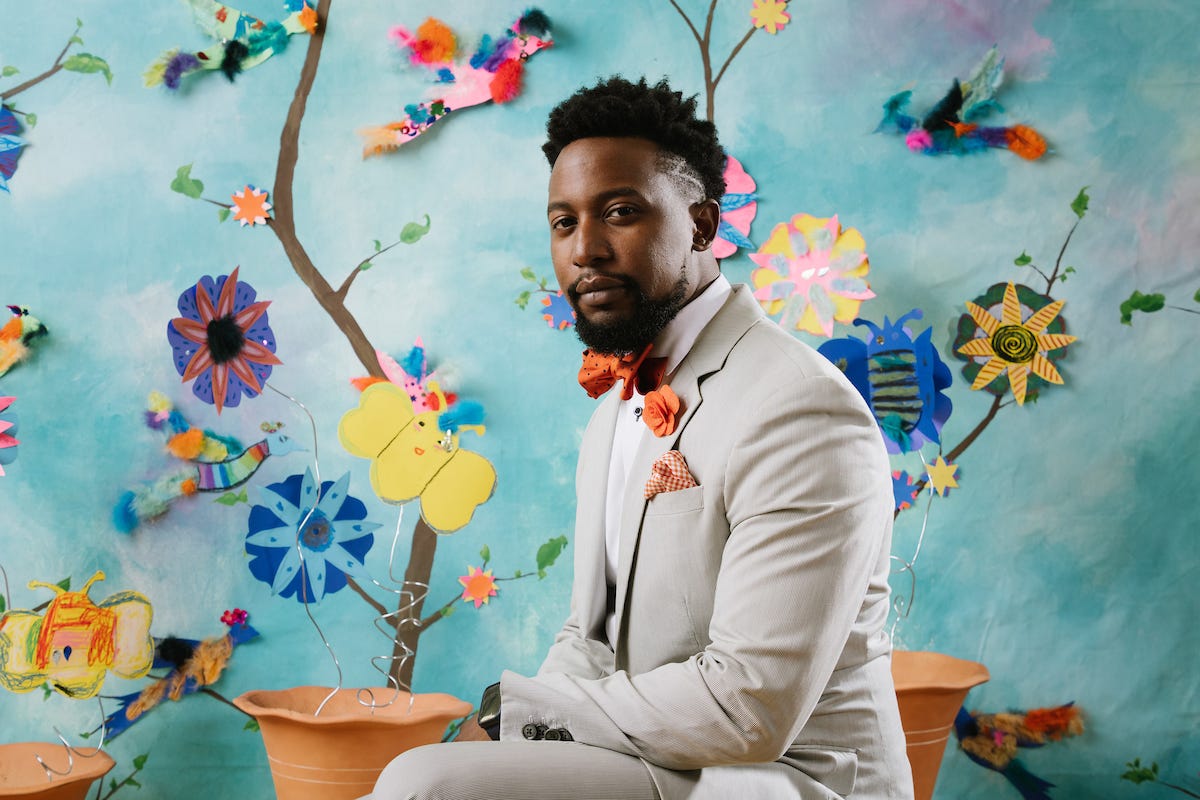
Today, I’m catching up with my friend and former Bowdoin College Art History classmate Mike Ritter. We are meeting at Five Horses Tavern in Boston’s South End to discuss his ongoing Beautiful Dot portrait project that captures the many faces of Dorchester in the space of local libraries. The project is funded as a Community Arts Experience by an Opportunity Fund grant from the city of Boston.
As a photographer based in Boston, Mike produces documents of culture and engages in artistry that focuses on representation, identity & place, and community building. He is an active participant in the cultural spaces of Massachusetts we investigated this month. Hailing from Pennsylvania, Mike moved to Boston after graduating from Bowdoin and was a photo lab manager and photo gallery manager before devoting his full time to freelance photography. He lives in Dorchester with his family.
On his website, Mike tells us: “I focus on telling stories that celebrate people, their work, and their communities with a sense of honesty, integrity and joy. My images strive to communicate and connect with both my subject and viewer on an emotional level.” In addition to drawing inspiration from his community and background in art history, Mike’s vision is drawn especially from photographers John Huet (and his Uncornered Project), Wendy Ewald, Eugene Richards, Erik Jacbos, and Mary Beth Meehan.
Mike served as the American Society of Media Photographers (ASMP) New England president for 6 years. His event work is available at Ritterbin Photography. Recently, Mike has been engaged in several portraiture projects, including the Wiley School Portraits, for which his depiction of the principal, “Mr. Chery,” as pastiche of Kehinde Wiley’s work (currently on view at Boston Museum of Fine Arts) became the online headline portrait when @MFABoston asked "What does leadership look like” (above). In addition to Beautiful Dot, Mike is at the beginning of a politics-through-portraits project about the safety of air quality in Boston Public Schools.
Kathleen: It's great to see you after so long since our time at Bowdoin together! Thanks so much for coming to talk with me for The Matterhorn. I’m interested both in your recent projects and your thoughts about Boston’s cultural spaces, which I’ve written about recently. I know our audience would be really curious to hear from a Dorchester resident and artist on the topic. Let’s start by talking about the project that you're still in the middle of: Beautiful Dot, the portrait project in Dorchester that’s happening in several library branches. How did you get the idea for it and why are you doing it?
Mike: Thanks for having me, Kate. So, all my work stopped in 2020 for the most part; it literally came to a standstill, and I was full time with my kids. Then, you know, the world started to come back online in 2021. Having that time to process a little bit, I decided I wanted to just photograph people in Dorchester. I set up my own little day in 2021 and it went really well. People really enjoyed having their portraits together, and I really enjoyed working with people again. Then a grant opportunity came up from the city. Through the grant money, I wanted to do more of these portraits around Dorchester at more locations and with more people, because there were limits to doing it in just one day and one location. I won my first grant, I think, mainly because I had those first portraits to show. Then I gave it the structure of using the libraries [for a shooting location], thinking they would be a good place due to the network I could tap into as well as easy advertising. It’s a good place to get people to come out to again [after the pandemic]. They needed to bring their head count up, so it was a pretty natural fit and from there it was just planning it out and advertising it.
The 2021 project was called Get Close as a contrast from the way we've all been told to be the last few years. This one started out as Get Close Dorchester, but I realized it had to be something different. That’s when it turned into Beautiful Dot. It’s the same style, but it has the message that there’s all these wonderful people and things in Dorchester that I’d like to tell people about and that I’d like to learn about myself. Despite living here a long time, there’s plenty of people I don’t know. At the same time, the community’s so close that I usually know someone else this person knows. It’s really tight knit. I’m creating a portrait of the whole community.
Selected photographs from Beautiful Dot via Mike Ritter:
It’s an interesting choice to use the library space for your work. When I was looking for the details of this branch we’re in, I came across a bunch of events: yoga and mindfulness, concerts, multilingual reading experiences…it seems that the BPL have really become vibrant cultural spaces. Why did you choose the libraries and how do you think libraries reflect or create community culture?
It is such an interesting place. You can learn how to apply to become a citizen there; you can vote there. You can get tutoring help there. You can get computer access there. I don’t know everything about them, of course, but from what I do understand they’re filling more and more of a role of what society needs beyond what they used to do. I pinch myself the way some things are becoming so privatized in America, and everything is about making a buck. So thank god we still have the library system! So I’m very happy to be a part of that in any small way I can, getting people back out there to the library. There’s so much more that’s possible, and I am surprised by what they have to offer already. For example, my kids have some gaps from the pandemic and I’m thinking about getting them some tutoring in the library. They have artist talks, magic shows for kids, and that’s great for both the kids and the freelance entertainers to get steady gigs. You can sign on with Kanopy and get free movies to your library account. I could learn more about the ways they’re getting into the digital age. I could take more advantage of it.
So you’re shooting your portraits in the libraries but you’ve also recently done an artist talk in one of the branches. How was that experience and what did people think of it?
It was great. If anything it made it make more sense to me. As painful as that is: what am I doing? What is this for? Aaah. It was really helpful to be forced to do that. It gave me some focus. I’m happy with how that presentation turned out, and it gave me a little bit of clarity. So, it was great and I have a wrap up talk at a different library in December. And, who knows, we may end up showing the portraits at a library, but I’m not really thinking about that yet since I’m in the middle of shooting still. Maybe I should be thinking about that now, but I’m doing a lot and I have my limits. [laughter]
I guess you might have some limits, but you’ve been involved in quite a few things recently. You did this project at your daughters’ school, and the portrait that you took of her principal became the face of the Boston MFA Portraits of Leadership project in juxtaposition with the Obama portraits. I was lucky to be able to see your work displayed at the MFA the other day; congratulations! [Click on the IG link above to see Mike’s work.] Can you tell us more about your project there in the school and what you were trying to say with it?
So the school portrait company wasn't coming to my girls’ school, and I didn’t have any work in 2020 [laughter], so I was like I'll do that much at least, just take some school portraits. I used to do school portraits regularly. Those [in 2020] we just did outside. It worked out fine. It was nice lighting, but it wasn't saying as much. It was just nice lighting since that's my forte, I guess.
Then in 2021, I managed to team up with the art program in the school and ask them if they wanted to do the background instead and involve the kids in doing something. At first they weren’t sure, then they came back about a week later with the idea of doing like a [Kehinde] Wiley inspired portrait. It sounded great. So they went off and did that; they painted the background; they came up with the velcro system. The third grade made the birds, the bees, and the flowers. They did a really good job. In the end, I just had this great background canvas to work with, and I worked on just the lighting part of it to make it look kind of like one of Wiley’s paintings with a kind of hard light. It worked out well really well. We got to combine their work with my lighting.
It was a big step up from the year before. It was a good lesson that things can work better through collaborating with people. At my girls’ school, I mean I don't know the exact numbers, but they're one of the few white kids, sometimes the only white kid in their classes. The reason Step Into Art, the program, was doing the Wiley stuff was because of the same reason Wiley does his work, which is to get minority people to see themselves differently and in positions of power or you know in connection to that whole artist cannon. We did a couple normal school portraits, then say something like, okay you're a queen or something and they just kind of go with it. They strike some poses and they work! They look kind of like those paintings in a 19th century 18th century kind of aristocratic way. It turned into much more than pretty lighting and a nice portrait. It had a meaning and subtext to it that the ones in 2020 did not.
And then when the Wiley portraits came to the MFA, or when they were on their way, and they asked for everyone to submit portraits of leadership, I had this one to submit. The portrait of the principal [Mr. Chery, pictured at top] was getting good reviews and got into the Griffin Museum for the member show, which I never got into before. So I sent it in to the MFA, and they took it and made it the cover of the digital submissions for portraits of leadership. That was such a nice blending of the project and the show of the Obama portraits at the MFA.
I had seen Kehinde Wiley’s work elsewhere, but I found the Obama portraits quite moving in person. I guess the beauty of his aesthetic mixed with the history embedded in his work as well as a such a modern take on a presidential portrait and the first Black president of the US made it such a powerful image in person. It felt very special to stand in front of it and then to see both the digital photos, including your own, and the school children’s images of world leaders in juxtaposition.
Mr. Chery is one of the few Black male principals in Boston and I found this quite powerful as well. It was really cool that they accepted this photo to showcase leadership in Boston. Research shows it matters for a Black kid to have at least one Black teacher in their elementary school, let alone a principal. He also came to the school on very short notice and started to make things happen quickly that I previously was told couldn't happen.
In that space at the museum, there are also these these pictures from from school children depicting different leaders like Rosa Parks, Obama, Malala…many people of color. It was so wonderful to see this. You also interviewed people in Dorchester about the community for Beautiful Dot and it seems like everyone was talking about diversity?
I worked with a reporter to come up with a few questions, basic questions to give people in the community. I didn't include the word diverse so much; I just had the question of what makes Dorchester beautiful to you? And so many people bring up the diversity. It’s not just that there are many people of color here, it’s also people in interracial relationships and couples adopting across race lines and purposely moving to Dorchester because they wanted to have their kid in an environment where there were more kids who looks like him.
That being said, being someone [who isn’t Black or a minority], I still feel very welcome here. And that’s something I really wanted to show here. I really just let the idea of diversity bubble up on its own without saying it explicitly. I love living in this place with so many things to learn. So many festivals and celebrations; my kids are now excited about Diwali. There are just so many faces and sides to show of Dorchester.
So, we studied art history at Bowdoin together, among other things since it is a liberal arts college. Could you tell us how this has influenced your work? I guess I mean especially within the frame of liberal arts, because this is something I talk about a lot in the newsletter – the value of interdisciplinary work. But maybe you think it hindered you! Tell us what you think…
I'll just first say I fell into my art history major a bit like I fell into freelancing. I lifted my head junior year and saw I had 3/4 of an art history / visual arts interdisciplinary major done and declared that along with my Spanish major. My wife studied art history at Syracuse and wonders aloud how I got a degree since my art history studies rambled from South Asia, to medieval cathedrals, to African American Diaspora of the 20th century.
But, art history paired with making art of your own is a great way to learn. You see art is about a lot of things... power, religion, money, communication, revolution, activism, and yes inspiration. But, you really get to see it's not made in some vacuum. It's in and of its time from who made it to who paid for it to who the intended audience was and what the message was.
I didn't get into my first photo class until junior year and it was not technical at all. Assignments were "photograph air" and "stay in one place for an hour and shoot a role of film." I liked this order as the technical really must come second to what photographers are actually trying to say. Bowdoin started me off first on what I wanted to say and really just an innocent exploration of the medium. It didn't let me get bogged down in perfect printing, perfect exposure, perfect anything really.
For me, liberal arts gave me a chance to get interested in lots of different things which carried over into my professional career. Photographers are at their best when they're as passionate about something else as they are about photography. While I'm excited about documenting my community of Dorchester and being an activist for better school buildings, I can also get excited for client work. The wide net of my education, I believe, helped prepare me for a wide net profession where I'm interacting with many different people and shooting in various ways for different reasons from day to day.
At Bowdoin, I feel I learned as much in my extracurriculars as my actual education. I got to take over the film society because the guys who were in charge were quitting. I signed on as president freshman year. My favorite movies were Blues Brothers and Caddyshack. I was at career services applying for an internship the day Kubrick died and the counselor I was working with came up and broke the bad news. I looked at him confused. He said, "You are the film society president, right? You don't know who Kubrick is?" I had no reason doing this other than no one else would.
I formed a team of society members who knew much more about film, and we scheduled pretty good seasons. I learned budgets and justifying getting more money. We added occasional drive in movies. I looked and learned Brad Anderson, who's a pretty cool director, was a Bowdoin alum. I invited him to school and he came with his brand new movie Session 9 in film in the trunk of his car. I think it was only on the film festival circuit at that point. We showed it at the Eveningstar Cinema in downtown Brunswick who we had partnered with. Brad ran a workshop on filmmaking and acting the next day.
I was forming community all along. I learned about bringing people together, sharing something I was excited about, being part of a team to do the best work, and all the boring stuff that goes into pulling it off well like simple organization, pre-production, marketing, and handling money with some skill. I learned about seeing the potential in something, striving for it, and enjoying the process all along the way. Lots of these soft and hard skills I use everyday on the various projects / jobs I have in wide ranging stages of development and execution.
On a different topic but still related to schools, I understand you’re tackling the problem with HVAC at your daughters’ school through photography. It sounds like the ventilation systems are at a crisis point. Can you tell us more about this and why you think photography can help to make a change?
In a way it comes from an angry place, but I think that’s ok. I’ve learned a lot from the way other people have created change by channeling their anger. I know the school committee has plenty of things to work on all at once, but the conditions are really just unacceptable. It’s been that way for decades.
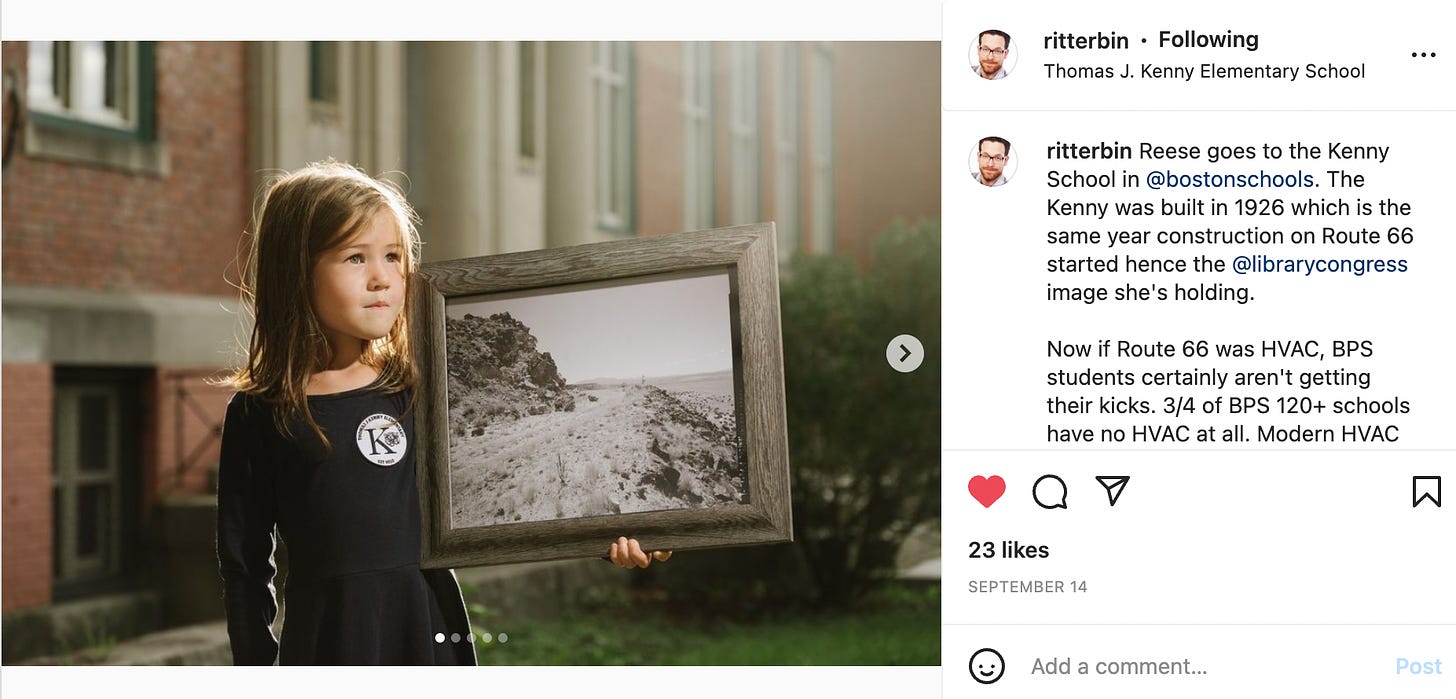
I started off just taking pictures of kids outside schools with their parents, and those were fine. But the issue was that it didn’t say as much as I wanted it to. After sitting on the idea for about a year, I decided to have the kids just hold an old looking frame with a historical picture from the year the school was built. Then the kids can both talk about the issue at their school and I can add research that I’ve done about it. A cute looking kid with one of these images and the accompanying information just drives home the issue of how old and unsafe their school is. Changes need to be made. There’s always a reason…but this…but that…there’s always some reason things aren’t happening. And I get it; bureaucracy isn’t moving. It makes a snail look fast. But at the same time, during the pandemic they were able to shift really quick. I’m willing to lend a sympathetic ear to individuals, but at the same time the system has proven they can make a change. This just can’t keep going on. It affects everything: their learning, their health, their teachers’ health. And the administration building redone in 2015/16 has won multiple architectural awards. The kids, meanwhile, literally don’t have safe drinking water in their schools. It’s not right.
I’m just enjoying documenting it. But at the same time it can make a difference. Art is the purest form of communication. It’s kind of like writing; where you might have all the elements, but don’t always hit home. And in the same way, after I made a few changes, I feel like this new more stylistic method I’m trying out can really make the issue stark and unavoidable. You can’t ignore it. This is it. This is real. This is a kid who goes to school in a school built in WWI.
Did you ever hear that Mark Twain quote, like I would have written you a shorter letter if I had the time?
Yes. Yes!
Well, that’s just it, it’s getting it down to something really small but impactful.
Sure, it’s editing and curation…and it’s coming from an artist who lives in Dorchester. I know you sometimes talk about yourself as an outsider, but you’ve lived there for so long that if it were a different country you’d have citizenship by now. And I think that you also gain something in perspective by both being someone who is an outsider and a part of the community; you can perhaps see more clearly.
There’s definitely advantages to having the outside eyes and that’s a part of it. But I’ve also lived here long enough to know that unless you were really born in Dorchester, or maybe Boston, there’s a different originally from Dorchester (OFD) feel that I’ll never have. But I really like the blend; you want it that way — people coming from elsewhere and from those who have been there for generations. I just love being a part of this community and being accepted here.
Well it would be great to catch up on this project in a few months to see how your work has impacted the community or, hopefully, the school committee.
I think it’s going to be years - twenty years maybe - but I’m working on at least getting a commitment to a change. I don’t think anything will be fast enough to really affect my kids before they’re out of school. I get that individuals have seen this for years and maybe aren’t sure where to start or feel frustrated. But I’m hoping even a little spark will help people get started. So sure, let’s chat about that soon.
I hope we get to hear about some progress at least. Good luck. Last question: how do you feel about selfies and phone photos in general? Do you take them? Do you have a lot of cloud space devoted to photos of your kids? Or do you shirk phone photos completely?
It’s amazing. They keep getting better. I do take photos on my phone but I don’t shoot that many. I’m very aware, though, as a photographer, I do immediately set up the situation in front of me and mess with the settings on the phone. I can’t just leave it alone. I probably take a lot less photos than the average person in this way. We went to an event the other night, and everybody was on their phones, it felt like, except for me. Maybe I’ll miss out on some memories, but at the same time: I was there. I was present. And maybe that’s better, I don’t know. I should shoot a few more of my kids, maybe, but at the same time I am there with them. Because you're not there in the same way when you bring a camera up to your eye, in my experience. Although I do want to take a few things to remember, and I feel like I’m balancing it pretty well, but it’s not easy. You can always do better and you can always do worse. I’m always figuring it out, just like with my work.
Thank you so much for speaking with us. It’s so great to hear about your work with portraits and the community. I really look forward to seeing the direction you go in next and where these current projects will lead you.
Thanks a lot for having me. Really great to catch up.
Mike Ritter’s Beautiful Dot project is running at several Boston Public Library branches this month. His other current project is making the problems with safe air in Boston Public Schools visible. You can sign the petition here.
In addition to his website, you can follow his work on Instagram or LinkedIn.





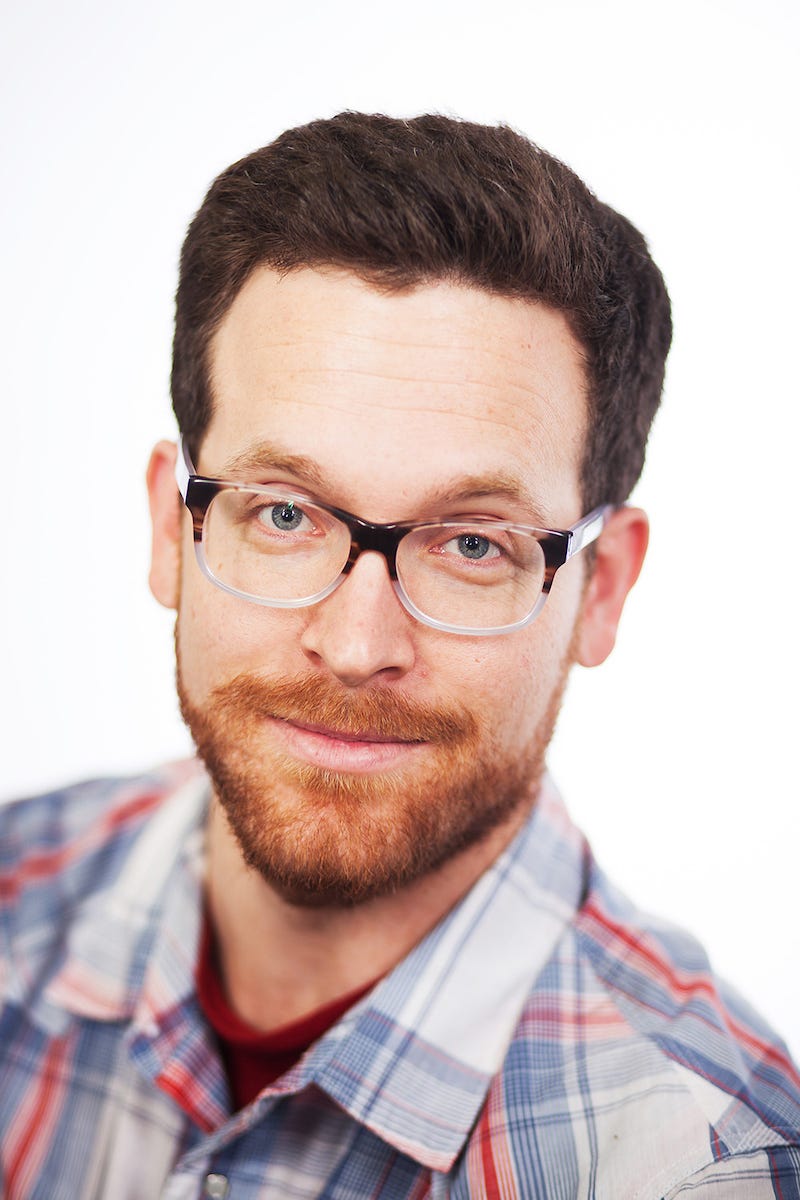

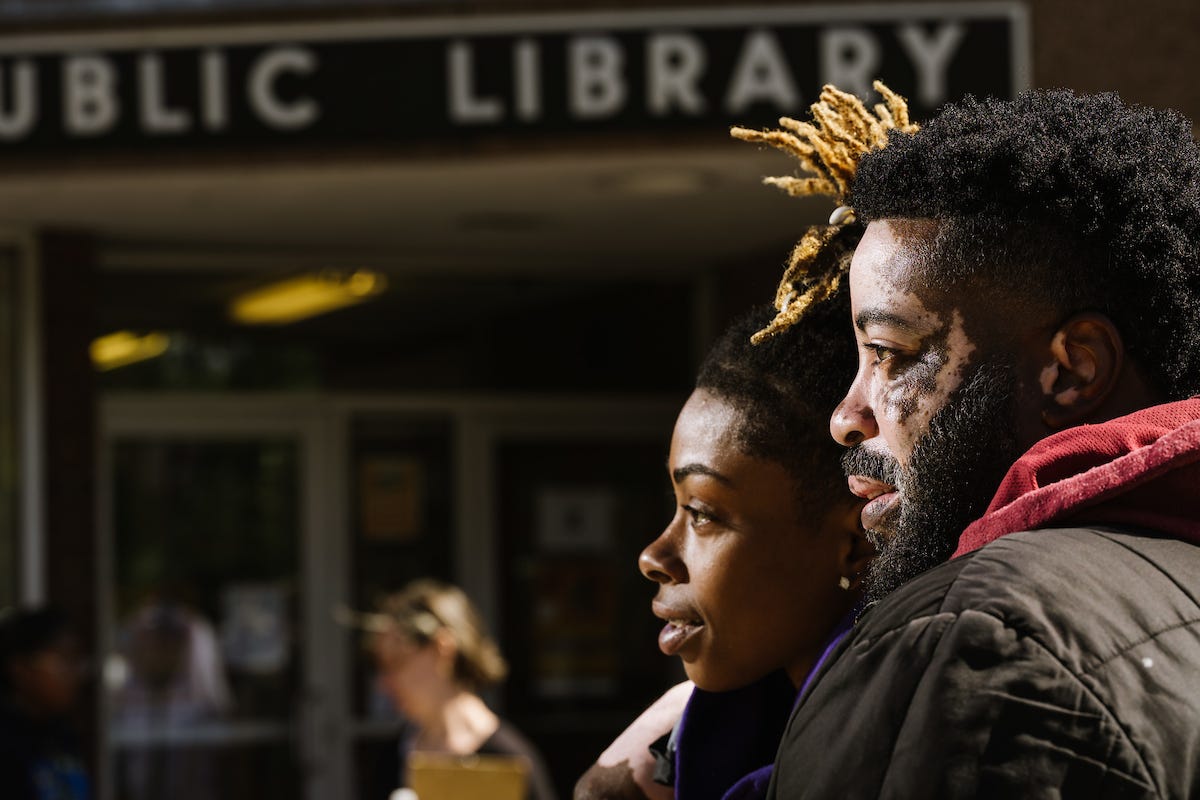
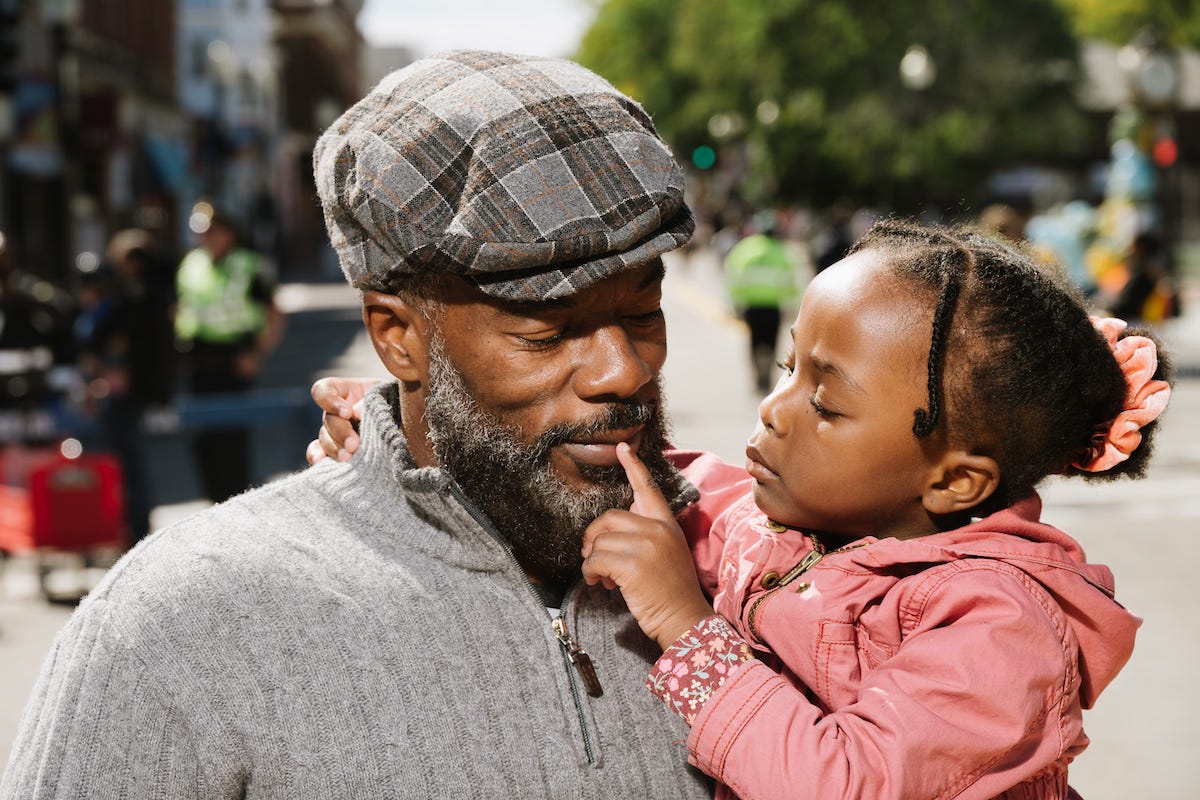
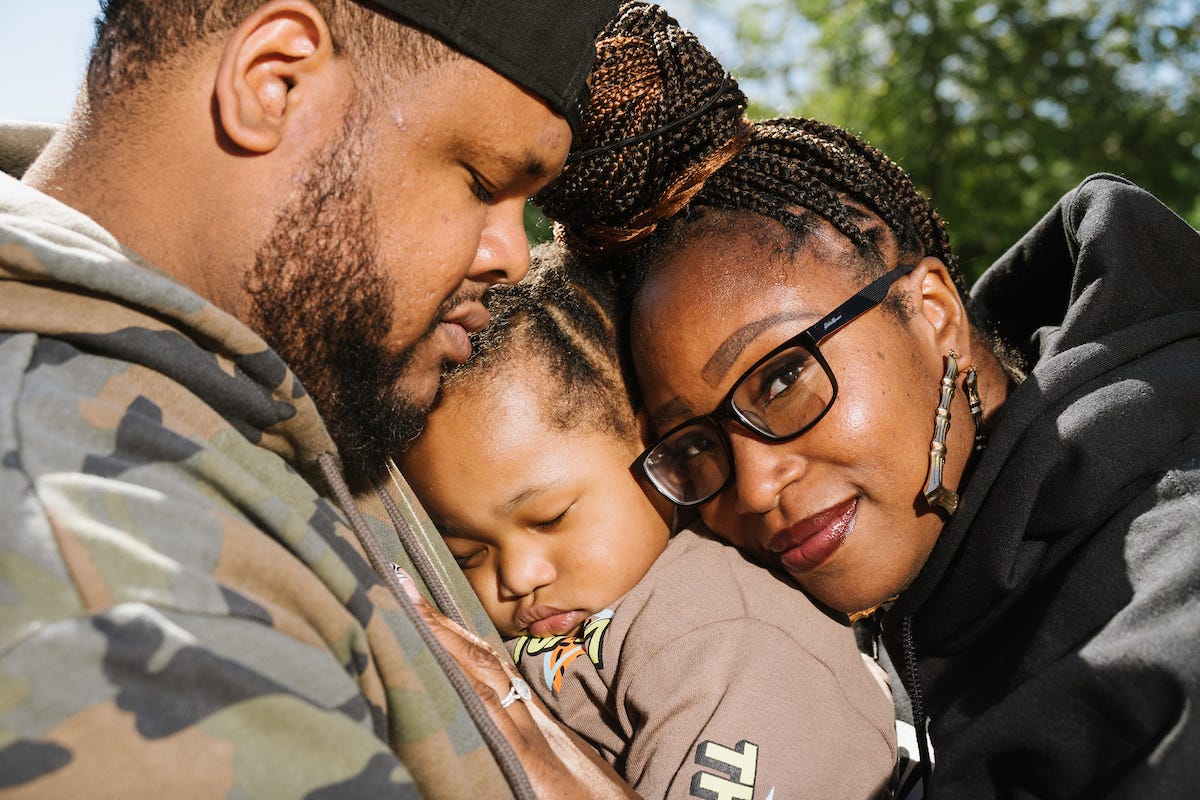
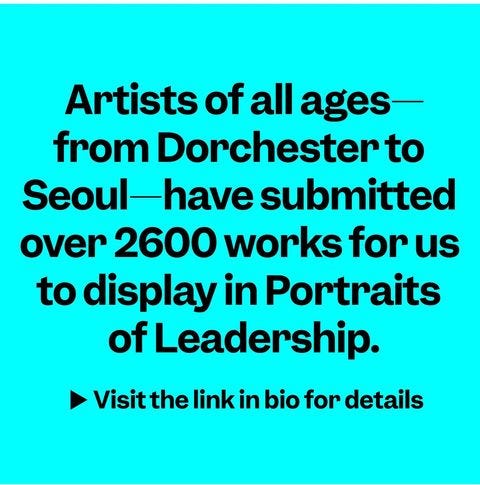
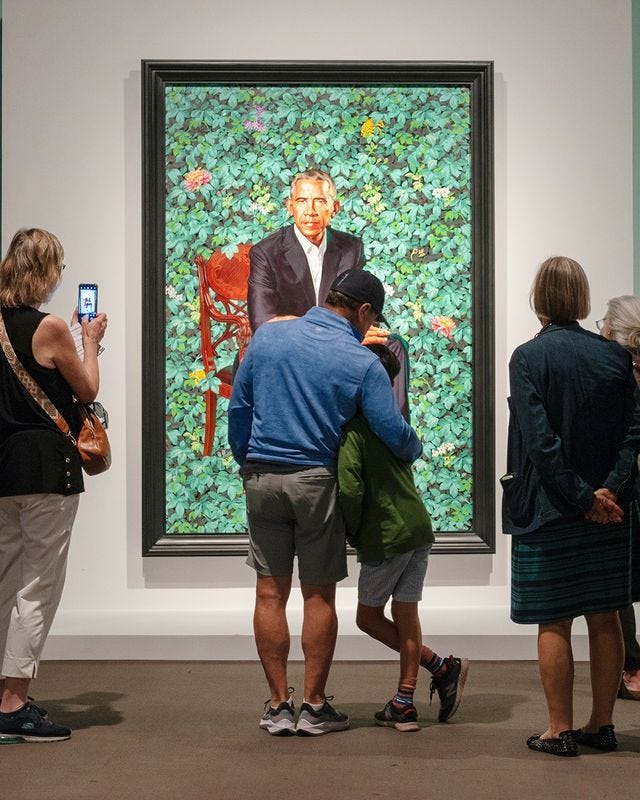
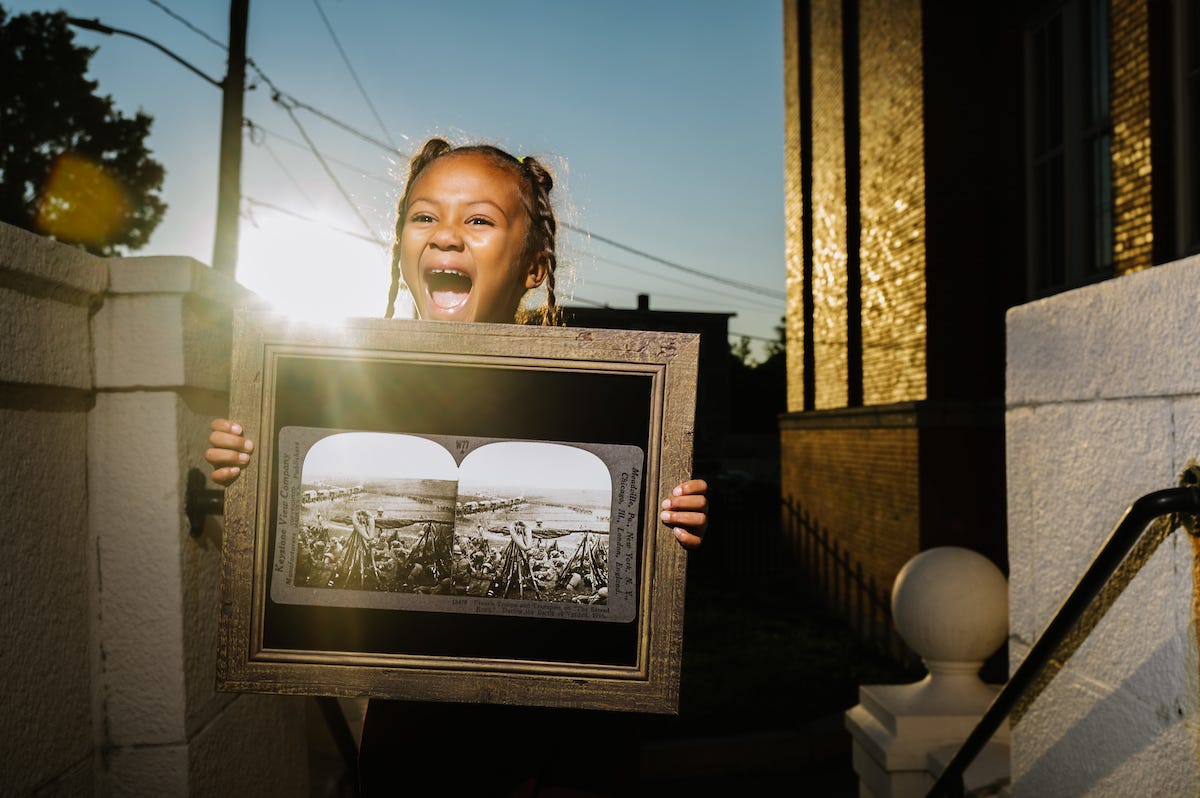

What a fascinating discussion - and how lovely to catch up with an old friend on your trip! I love Mike's family portraits, and especially that they are taking place in public libraries : )
Thanks for the wonderful interview, Kate! I'm happy it's spreading the word particularly on the HVAC portraits.